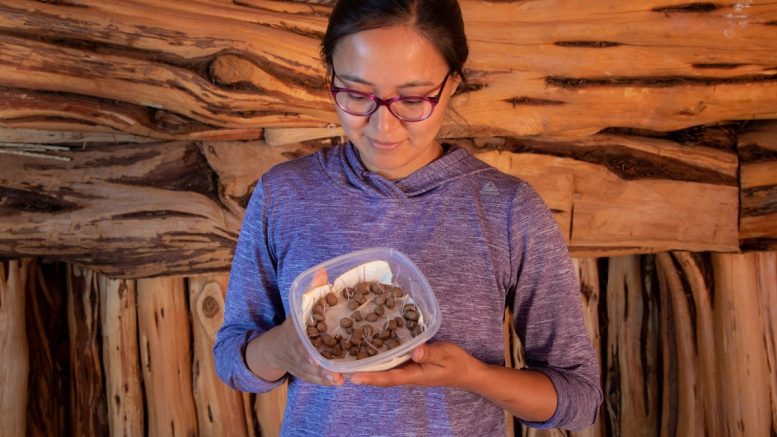Indigenous communities of the Southwest work to ‘rematriate’ the Four Corners Potato.
by ALASTAIR LEE BITSÓÍ
FIRST MESA, ARIZONA – With drought a persistent problem in the Southwest, Hopi/Tewa seed keeper Valerie Nuvayestewa has eagerly joined the effort to bring back an Indigenous superfood that her ancestors cultivated for 11,000 years. The Four Corners Potato can grow under dry conditions and provides triple the protein and twice the calcium of red organic potatoes.
Scientists and leaders of Indigenous communities in the region have launched a drive to reintroduce the drought-resistant tuber, known scientifically as the Solanum jamesii, as a possible food solution for people hit by impacts of climate change. University of Utah scientists and Indigenous food activists say the spud can stay dormant for years under dry conditions, still offering nutritional benefits like iron and zinc to humans.
“I have never grown the Four Corner Potato before, so this is going to be a challenge as I’m learning as I grow,” Nuvayestewa said.
The need for innovative crops has grown more obvious since August 9, when the United Nations Intergovernmental Panel on Climate Change released a report saying human influence has warmed the atmosphere, ocean, and land to levels “unprecedented” over the past 2,000 years. The IPCC authors said the Southwest is expected to get hotter by 2 degrees, with drought growing more common in coming decades. Extreme precipitation that can lead to flooding also is projected to increase, as illustrated by this summer’s heavy rains across Arizona, Colorado, New Mexico, and Utah.
A history dating back thousands of years
Nuvayestewa’s introduction to the Four Corners potato came this spring, when the nonprofit Utah Diné Bikéyah’s Traditional Foods Program invited her to be part of its Potato Cultivation Project. In recent years, researchers discovered evidence that the potato was grown in Utah thousands of years before potatoes were thought to have been brought to North America from the Andes.
Cynthia Wilson (Diné), director of Utah Diné Bikéyah Traditional Foods Program, said food activists and environmentalists hope to “rematriate” the Four Corners Potato. Rematriation is defined as encouraging local communities and other humans to cultivate native plants in a reciprocal manner in reverence with the natural environment through matrilineal teachings and values. Thus, the efforts to connect the potatoes to Indigenous seed keepers like Nuvayestewa.
In her first growing season using the seeds, Nuvayestewa said she transplanted them from smaller pots over the summer into bigger pots. Some didn’t survive the transplanting, but she still has quite a few plants left. She plans to share her harvest after she has enough to give to other gardeners and farmers in her village.
“I’ve grown other varieties of potatoes, but the Four Corners Potato is different and does not like too much moisture,” she said. “Of course, it still needs some moisture to grow, but it can also lay dormant until the rains come. There has been little rainfall over the past five years, and only recently did we receive a lot of rain where I live in First Mesa, so we are seeing more green plants around the mesas instead of the dry, brown, bushes.”
CONTINUE READING ON: Yale Climate Connections

